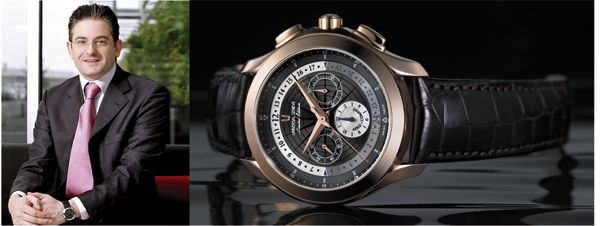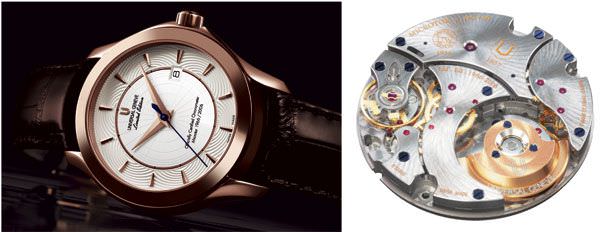The re-launch
The re-launch of Universal Genève in 2006 was received by some with caution. The brand is almost as famous for its changing management as it is for its historical mechanical innovations. “In the beginning, we were asked a lot of questions about the past, but those questions have gone now. People were very leery, but now they know that we are committed,” Lapaire says. And he certainly is working hard - with three collections and 18 points of sale in Japan and Hong Kong, the brand is safely over the first hurdle.

Vincent Lapaire and the OKEANOS AERO-COMPAX
Attention to detail
Talking with Vincent Lapaire, it is clear that his focus is on the products, continuously fine tuning and adjusting the watches in the search of perfection. The classic cases have been reshaped with slightly lengthened lugs and a slimmer bezel to accentuate their elegance. Particular attention has also been paid to the crowns that took over a year to produce and are made in three parts - with gold, enamel and resin. The alligator straps are equally interesting with their very large scales. All of Universal Genève’s watches are 100% Swiss made, except for the straps. Lapaire wanted to work with the brand’s original Parisian strap supplier as it uses an unusual African alligator skin that is cut vertically and has a wilder appearance - small details that go together to create classic and elegant collections.
Microtor UG100
One of the initial lines re-launched last year was the Microtor UG100, based on the company’s historical UG1-69 movement. Famous for its off-centre rotor, the Microtor was first introduced in the 1950s. Universal Genève enlisted the help of retired watchmakers, who had worked on the original Microtor, to help with the redevelopment of this new movement. The Microtor’s small rotor has the advantage of not adding to the thickness of the movement like the common centre rotors do, and despite its small size, it provides a good power reserve of around 44 hours.

Microtor in pink gold and Microtor UG movement
Taking care of the past
Universal Genève is certainly looking to the future, but it isn’t ignoring the past – it has set up an after-sales department which repairs between 30 and 40 antique timepieces per month. “We take care of the new watches, but we also take great care of the antique watches. The patrimony of Universal must be taken care of and we have sorted a massive amount of antique parts so that we can respond to 80% of the demand,” explains Lapaire. “The parts were not destroyed, they were in bulk boxes. We used different watchmakers to go through the boxes to sort them and finish them. When someone has a Compax Chronograph from 1945, not 1944, and he wants the correct hands, we can determine whether we have the parts, and if we don't, we find them in the network of antique parts owners.” Now that’s service for you.
The Future
Universal Genève will be introducing core lines this year, such as a steel series of Microtors. After the attractive limited editions of 2006, serial production starts. The plan is also to open new markets, especially in Europe. On the production side, “The future is to concentrate on our own movement manufacture. We are investing mass-ively so that we do not use any parts from the outside,” Lapaire says. It may take Universal Genève a while to restore itself to its former glory, but it’s definitely on the right track.
Source: Europa Star February-March 2007 Magazine Issue





